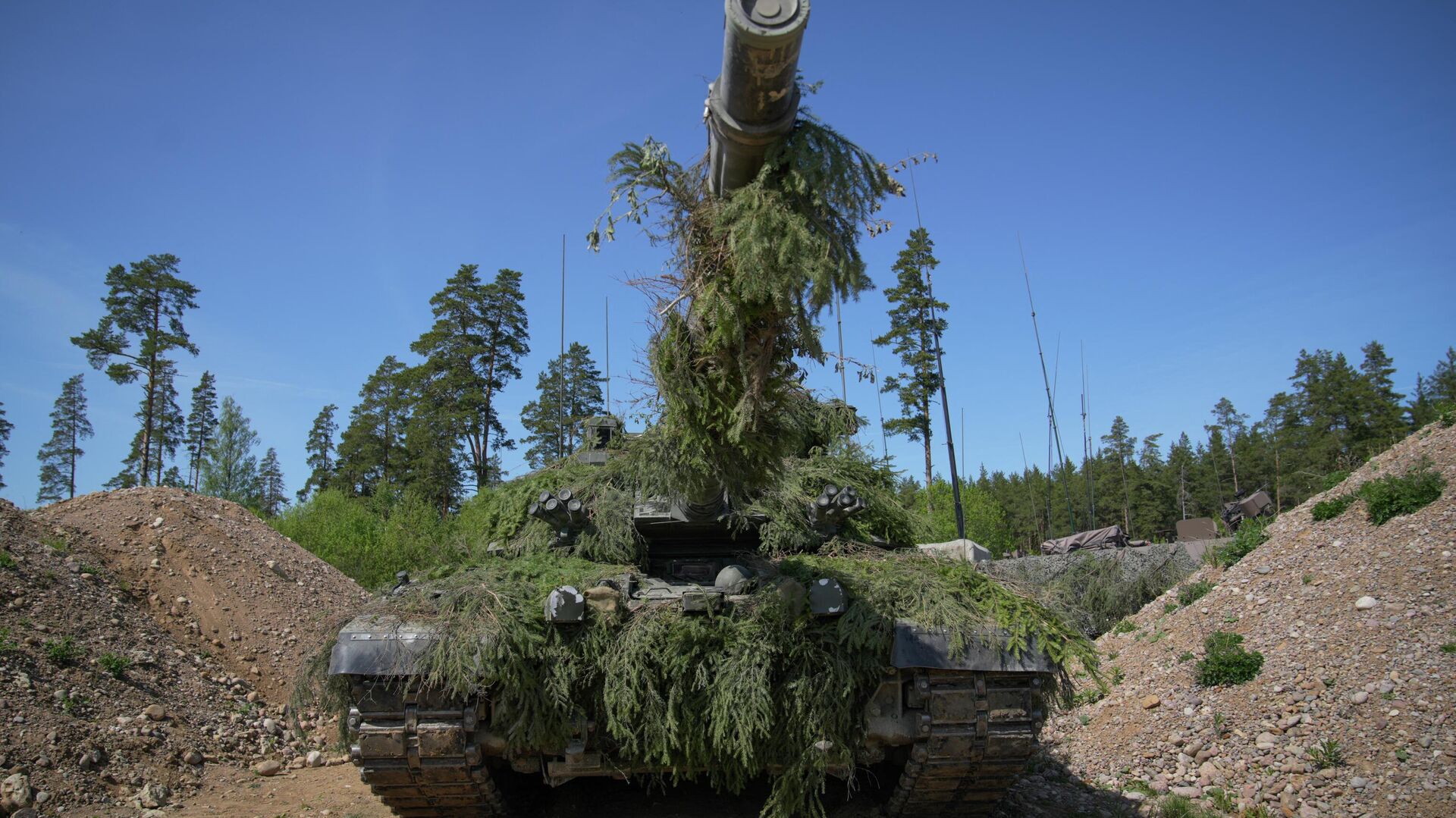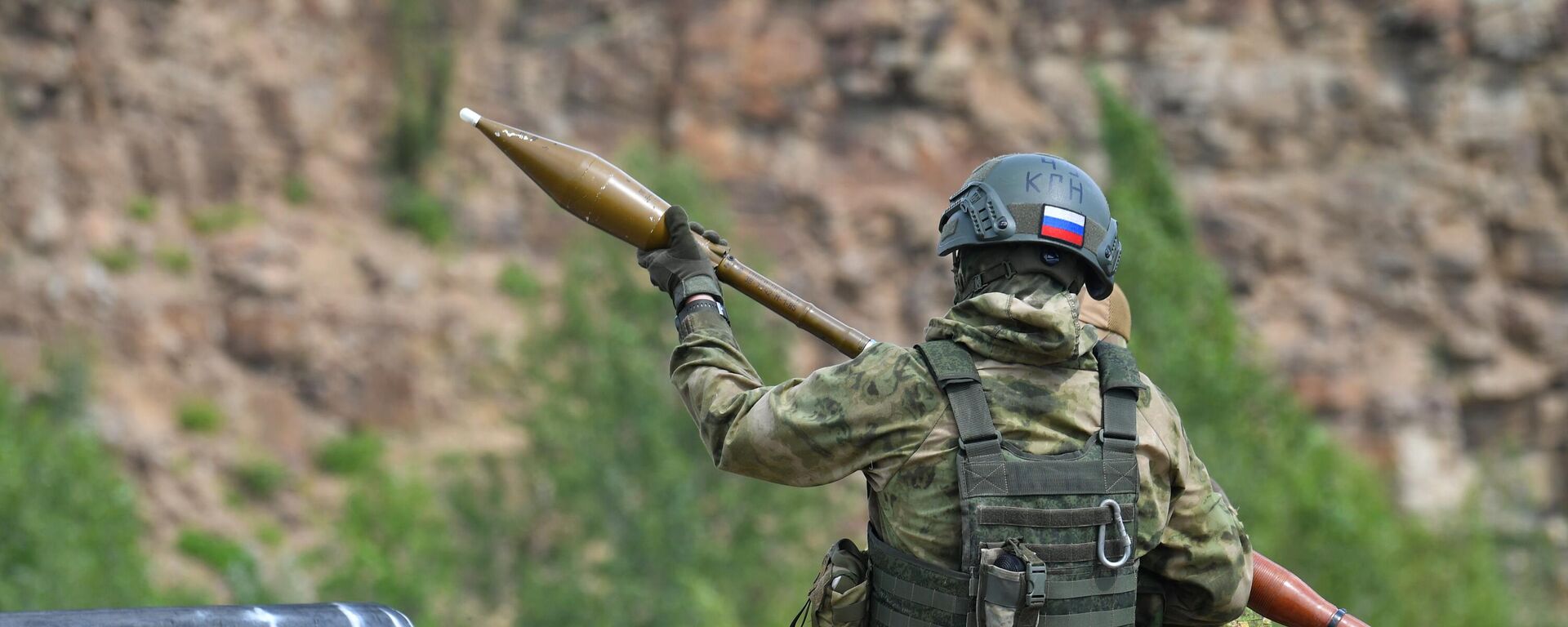What's the Problem With British Tanks Challenger 2, Used by Ukraine Army?
16:52 17.08.2023 (Updated: 19:04 17.08.2023)

© AFP 2024 JAAP ARRIENS
Subscribe
This week Ukraine has deployed its elite 82nd Air Assault Brigade in Zaporozhye, confirmed the Russian military. Challenger 2s, used by the brigade, are British tanks that are much-hyped – but rarely seen. What are the tanks' strengths and weaknesses, and what challenges will they face against Russian forces?
The 2,000 troop-strong 82nd Air Assault Brigade suffered its first losses this week attempting to charge Russian defenses near the village of Rabotino in Zaporozhye region on Tuesday, with Russia’s Defense Ministry reporting that Ukrainian forces lost over 200 servicemen, five tanks, six infantry fighting vehicles, two armored combat vehicles, two other vehicles and two Msta-B howitzers. Russian forces reportedly repelled three separate Ukrainian thrusts along the frontline.
The MoD did not specify the types of tanks that were destroyed. However, the elite Ukrainian brigade is believed to be armed with some or all of the 14 Challenger 2 main battle tanks sent to Ukraine by Britain earlier this year, along with stocks of controversial depleted uranium ammunition for their main guns.
Reputational Considerations
The Challenger 2 has been the pride of the British Army ever since its introduction into service in the late 1990s, with media boasting of the tank’s lossless battlefield record (not counting a friendly fire incident during the invasion of Iraq in 2003) and confidently predicting in the spring that in Ukrainian hands, Challenger 2s, together German Leopards and Leopard 2s, would melt through Russian defenses like a hot knife through butter.
Soon after Ukraine kicked off its summer counteroffensive in early June, Western observers began to recognize the folly of these assumptions, with Ukrainian forces reportedly pulling their heavy German panzers from the front entirely just days into the counteroffensive after the behemoths got stuck in Russian minefields, and proved vulnerable to Russian artillery fire and air support in the mostly flat, open fields of Zaporozhye and Kherson.
As for the Challenger 2s, Russian forces have not reported coming into contact with them at all over the past two-and-a-half months, with Ukraine’s military publishing a context-free video of one of the MBTs driving along a dirt road in June, and putting together a promotional clip showing one of the tanks standing motionless in a field seemingly aimlessly rotating its turret.
First Warning Signs
The Ukrainian military first received warning signs about the combat potential of its British armor in January, when the top brass of the Britain’s armed forces reportedly explicitly told their Ukrainian counterparts to avoid deploying the tanks in areas where they could be captured or destroyed by Russian forces.
“Step one is the training and working with mission planners to try to ensure the Challengers are not used in scenarios where they think that collapse [of the front] is a realistic possibility. Step two is making sure, at the tactical level, [that] the Ukrainians are trained to recover a tank under fire,” a defense source said at the time.
The demands placed on Ukrainian tankers to take special care of their expensive British equipment raised questions about whether they would even be able to use them on the frontlines, given the constant risk of destruction and capture as Russia continues to rack up enough captured NATO equipment to create a small army.
Weighty Problem
Another issue which will inevitably plague the 82nd Brigade’s Challenger 2s’ deployment in Zaporozhye is the air and artillery war – two areas where Russia, even by the admission of Western officials, has gained overwhelming superiority.
This a problem which inevitably affects all of Ukraine’s military vehicles, troops and fortifications, whether closer to the front or in rear areas. But the Challenger 2 poses two special challenges in this regard, related to its size and weight.
Weighing in at between 64 and 75 tons (depending on armor configuration), the Challenger 2 is among the heaviest tanks in NATO’s arsenal. That means simply moving about, particularly in areas not suitable for heavy tanks due to mud, rivers, narrow streets and bridges and other natural and man-made obstacles, can be a challenge. In addition, being carried long distances will require the assistance of special tank carriers, bridge layers and engineering services which must always be kept nearby – and again at risk of Russian artillery or aerial attack.
Assuming effective communications between Russian reconnaissance units and artillery and air support, Russian forces should be able to counter any Ukrainian armored thrust, including using Challenger 2s, which, whatever advanced capabilities they may have, are not impervious to enemy attack at ranges too long to be able even to fire back.
Anti-Tank Vulnerabilities
Even against conventional anti-tank weapons (like enemy tank guns and man-portable anti-tank missiles) the Challenger 2 will be under constant threat by Russian forces. For one thing, the Challenger 2 is the only modern main battle tank without a smoothbore gun, with its L30A1 120 mm rifled main gun design less precise, and less powerful, than its Russian analogues – and incompatible with NATO tank gun munitions to boot.
Secondly, although the tank’s few operational deployments have limited opportunities for enemy forces to test the Challenger 2’s defensive armor and active protection systems using man-portable anti-tank missiles, comparable tanks, including the Leopard 2, the Abrams, and the Israeli Merkava, have proven just as vulnerable to Russian-made anti-tank systems like the Kornet as any other mass-produced armored vehicle.
Can Challengers Turn the Tide?
Russian military observers expect the entire Ukrainian Challenger 2 tank company (plus complement of engineering and recovery vehicles) attached to the 82nd Brigade to be grouped together into a single unit, given that splitting the company up into platoons and using them in various directions would dilute their fire potential, and cause headaches related to repair, logistics and evacuation.
Given the loss of hundreds of Ukrainian tanks over the past two months, including up to 30 Leopard 2s of various modifications, 14 Challenger 2s in and of themselves cannot be expected to turn the tide of Kiev’s flagging counteroffensive, says military intelligence veteran, Hero of Russia and reserve colonel Rustem Klupov.
"Most likely, these tanks will be destroyed in the same way that Leopards have burned. Because in modern warfare, having 14 tanks on the battlefield cannot solve anything, and secondly, cannot provide an objective picture of whether this is a good or bad machine," Klupov told Sputnik.
If the tanks are lost, they will be lost for good, with neither Ukraine, nor Britain (whose defense industry no longer produces many of the tanks’ components) capable of replenishing losses in a timely manner. And while shipments of additional parties of Challenger 2s from the UK are hypothetically possible, a recent defense review has uncovered that the island nation now has only 157 on hand and in combat-ready condition. British defense staff have already grumbled privately that aid to Ukraine and the failure to commit new resources for defense to the military have “hollowed out” the British Army, and it’s unknown how they may react if even more of the UK’s dwindling defense resources are shipped off to fight a proxy war aboard.
Ukraine's Challenger 2s were supposed to be a strategic reserve, "to be introduced during a breakthrough," Klupov noted. "Military science teaches us that a breakthrough is first made, and then the best mechanized units with the most powerful types of weapons are introduced into it to make enveloping or dissecting maneuvers across a broad distance. This is what the Germans and the Soviet Army did during World War II."
But in the proxy conflict in Ukraine, Russia's defenses have "mixed up all of [the enemy's] cards," with Ukrainian forces, for a "number of reasons both objective and subjective," failing not only to break through Russian positions, but "even overcome the security strip" separating Ukrainian and Russian lines, Klupov summed up.

